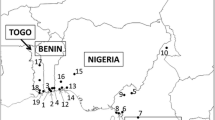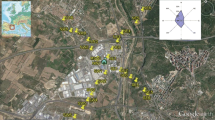Abstract
The municipality of Limoeiro do Norte-Ceará, located in northeastern Brazil, stands out as a major center of agribusiness due to the high productivity indexes, especially in the irrigated fruit production, with a high consumption of pesticides, including glyphosate, considered potentially carcinogenic by International Agency for Research on Cancer (IARC). In this context, the aim of this study is to evaluate the atmospheric pollution caused by the use of glyphosate herbicide in the rural and urban zones of the municipality of Limoeiro do Norte, evaluating the impacts on the environment and health of the population. Samplings were performed over a period of 4 months using calibrated air samplers. Concentrations of TSP and glyphosate were estimated by gravimetric and liquid chromatography methods, respectively. The results showed TSP levels between 10.8 and 137.4 μg/m3 (mean of 41.1 μg/m3) in rural zone and between 3.87 and 97.7 μg/m3 (average of 38.1 μg/m3) in the urban zone. The glyphosate associated with TSP in the rural zone presented levels between 0.002 and 0.144 μg/m3 (mean of 0.055 μg/m3) and the atmospheric TSP (gas phase) showed levels between 0.313 and 2.939 μg/m3 (average of 1.218 μg/m3). The glyphosate associated with TSP in the urban zone ranged from 0.009 to 2.576 μg/m3 (mean of 1.006 μg/m3). These values can be considered high and dangerous to human health and to the environment.







Similar content being viewed by others
References
Agência de Desenvolvimento do Ceará (ADECE). (2011). Perímetros públicos irrigados do Ceará, 2011. Conselho de Desenvolvimento Econômico.
Agência de Desenvolvimento do Ceará (ADECE). (2013). Perfil da produção de frutas, Brazil, Ceará, 2013. Conselho de Desenvolvimento Econômico.
Agência Nacional de Vigilância Sanitária (ANVISA). (2014). Programa de Análise de Resíduos de Agrotóxicos em Alimentos.
Chang, F. C., Simcik, M. F., & Capelz, P. D. (2011). Occurrence and fate of the herbicide glyphosate and its de gradate amino methyl phosphonic acid in the atmosphere. Environmental Toxicology and Chemistry, 30, 548–555.
Empresa Brasileira de Pesquisa Agropecuária (EMBRAPA). (2013). Sistema Brasileiro de Classificação de Solos. ed. EMBRAPA. 353 p. 3.
Freitas, B. M. C. (2010). Marcas da modernização da agricultura no território do Perímetro Irrigado Jaguaribe-Apodi:uma face da atual reestruturação socioespacial do Ceará. Dissertação [Mestrado em Geografia] Universidade Estadual do Ceará. Fortaleza.
Instituto Brasileiro de Geografia e Estatística (IBGE). (2010).Censo Populacional, Brasil.
Instituto Brasileiro de Geografia e Estatística (IBGE). (2015). Indicadores de Desenvolvimento Sustentável (IDS), Brasil.
Instituto Nacional do Câncer (INCA). (2015). Posicionamento do Instituto Nacional de Câncer José Alencar Gomes da Silva acerca dos agrotóxicos. Brasil: Ministério da Saúde.
Instituto Brasileiro de Geografia e Estatística (IBGE). (2019). Frota de Veículos 2014 – Limoeiro do Norte, Brasil. Disponível em: https://cidades.ibge.gov.br/brasil/ce/limoeiro-do-norte/pesquisa/22/28120?ano=2014. Accessed 18 Apr 2019
International Agency for Researchon Cancer (IARC). (2015). Some organophosphate insecticides and herbicides. Lyon: IARC Working Group on the Evaluation of Carcinogenic Risks to Humans.
Jauhiainen, A., Rasanen, K., Sarantila, R., Nuutinen, J., & Kangas, J. (1991). Occupational exposure of forest workers to glyphosate during brush saw spraying work. American Industrial Hygiene Association Journal, 52, 61–64.
Marinho, A. M. C. P. (2010). Contextos e contornos da modernização agrícola em municípios do Baixo Jaguaribe-CE: o espelho do (des)envolvimento e seus reflexos na saúde, trabalho e ambiente. Tese [Doutorado em Saúde Pública] Universidade de São Paulo, Faculdade de Saúde Pública. São Paulo.
Morshed, M. M., Omar, D., Mohamadz, R. B., & Wahed, S. B. A. (2011). Determination of glyphosate through passive and active sampling methods in a treated field atmosphere. African Journal of Agricultural Research, 6, 4010–4018.
Richard, S., Molesmi, S., Sipahutar, H., Benachour, N., & Seralini, G. E. (2005). Differential effects of glyphosate and roundup on human placental cellsand aromatase. Environmental Health Perspectives, 113, 716–720.
Rigotto, R. M. (2011). Agrotóxicos, trabalho e saúde: vulnerabilidades, resistência no contexto da modernização agrícola no Baixo Jaguaribe/CE. Editora Edições UFC/ Expressão Popular, 612 p. Fortaleza.
Rigotto, R. M., Silva, A. M. C., Ferreira, M. J. M., Rosa, I. F., & Aguiar, A. C. P. (2013). Trends of chronic health effects associated to pesticide use in fruit farming regions in the state of Ceará, Brazil. Revista Brasileira de Epidemiologia, 16, 763–773.
Santiago, A., Prado, R. J., Modesto Filho, P., & Alonso, R. V. (2015). Characterization of suspended particulate matter in the air of Cuiaba-MT-Brazil during the forest burning period. Revista Matéria, 20, 273–283.
Saraiva, K. R., Viana, T. V. A., Costa, S. C., Coelho, E. L., Celedonio, C. A., & Lima, G. (2013). Influência da densidade de plantio da cultura da melancia sobre suas características de produção, na Chapada do Apodi, CE. Revista Brasileira de Agricultura Irrigada, 7, 128–135.
Silva, F. L. (2012). Ambiência e biofertilização no cultivo orgânico do figo em condições semi-áridas. Tese[Doutorado em Engenharia Agrícola] Universidade Federal do Ceará. Fortaleza.
Soares, C. G. C. S. (2017). Caracterização físico-química de material particulado atmosférico coletado em Ipanguaçu, no Vale do Açu/RN. Dissertação [Mestrado em Ciências Climáticas], Universidade Federal do Rio Grande do Norte. Natal.
Author information
Authors and Affiliations
Corresponding author
Additional information
Publisher’s note
Springer Nature remains neutral with regard to jurisdictional claims in published maps and institutional affiliations.
Rights and permissions
About this article
Cite this article
de F. Sousa, M.G., da Silva, A.C., dos Santos Araújo, R. et al. Evaluation of the atmospheric contamination level for the use of herbicide glyphosate in the northeast region of Brazil. Environ Monit Assess 191, 604 (2019). https://doi.org/10.1007/s10661-019-7764-x
Received:
Accepted:
Published:
DOI: https://doi.org/10.1007/s10661-019-7764-x




